Here is a list of famous Greek statues and where to find them – as they are not all in Greece, you know.

Step into the world of ancient Greece and marvel at the exquisite masterpieces that have captured the hearts of art lovers for centuries. From their lifelike expressions to intricate detailing, Greek statues are a testament to the skill and devotion of their creators.
In this blog post, we’ll take you on a journey through time as we explore some of the most incredible Greek statues ever created. Whether you’re an avid art enthusiast or simply looking for inspiration, these ancient Greek artifacts and sculptures will leave you in awe!
Ancient Greece is a period that people look back on and admire. Indeed, there was plenty of bloodshed and drama, but that makes history so interesting!
We’re left with countless artifacts, buildings, ruins, and statues related to history, but the Ancient Greek statues are perhaps some of the most fascinating. Many are incredibly well-preserved, so they have been moved into museums to help keep them in the best shape possible.
Some are still in Greece, mainly in Athens, but some have been moved overseas to be housed in important museums and galleries.
If you’re a fan of Greek statues, let’s check out some of the most famous and where you can see them.
Skip Ahead To My Advice Here!
1. Aphrodite Of Milos – Venus de Milo, The Louvre Museum
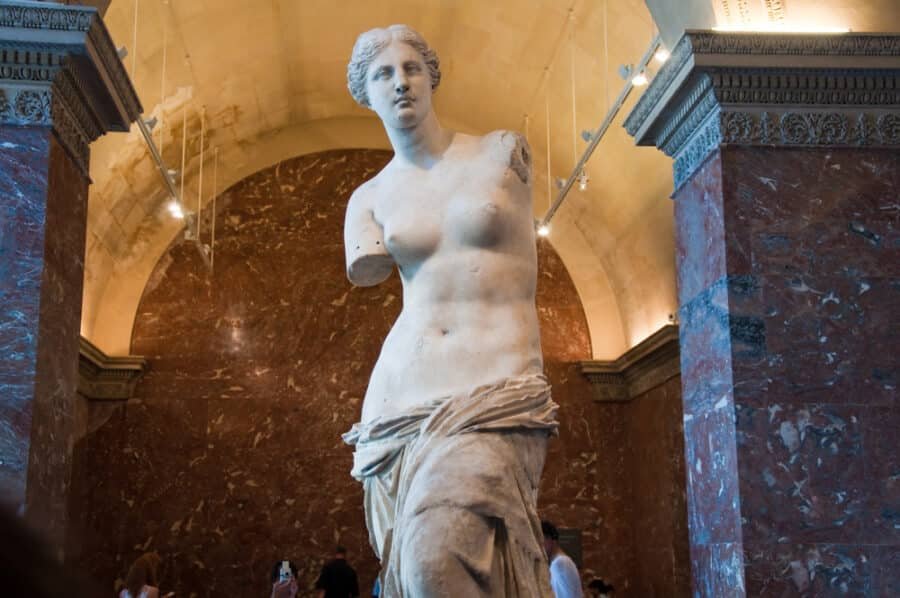
This is perhaps one of the most famous Greek statues of all time, and it was created around 130-100 BC. Alexandros of Antioch is thought to be the artist responsible for this statue.
The Aphrodite of Milos is made of marble and is 203cm high. It was found on Milos in 1820, and a considerable amount of mystery surrounds it. Why is the body so long, and what exactly is happening with the facial expression?
You can see this statue in The Louvre in Paris.
2. The Colossus Of Rhodes, Rhodes Island
One of the Seven Wonders of the Ancient World, the Colossus of Rhodes, was a towering statue of the sun god Helios that stood at the harbor entrance on the island of Rhodes. Although it was destroyed by an earthquake in 226 BC, parts of the statue’s enormous feet still remain today.
3. The Lady of Auxerre, The Louvre, Paris
Created in 625 BCE, this beautiful limestone statue can be found in the Louvre Paris. It was initially found in a storage room in the Auxerre Museum, and there is very little background information on why the statue was built, who built it, and how it ended up in Paris. You could say this statue is a mystery, but that’s precisely what makes it so special. However, the working theory is that the Lady of Auxerre is actually Persephone, who was Demeter’s daughter.
4. Nike Of Samothraki – The Winged Victory of Samothraki, The Louvre
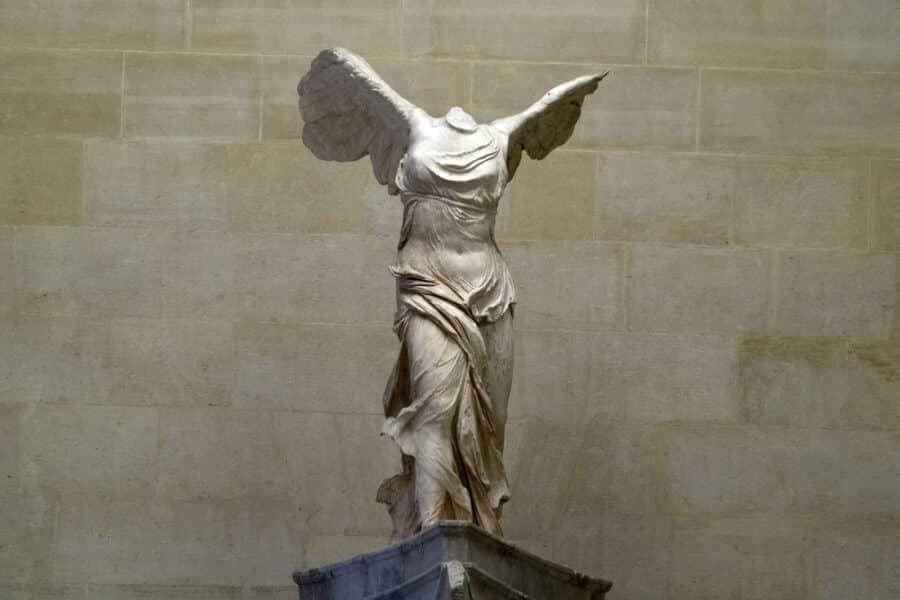
This particular statue, also known as the Winged Victory of Samothrace, dates back to the 2nd century. It is a Hellenistic sculpture of the Goddess Nike and was created by Pythocritos. The statue was discovered in Turkey in 1863, and at the time, it was broken. However, it was pieced back together, and the Goddess of Victory can now be seen in person in the Louvre Paris.
The statue represents the goddess as a woman with wings, and she is standing on a ship, with the strong winds blowing straight at her.
5. Kleobis and Biton, Delphi Archaeological Museum, Delphi
This statue was built in 580 BCE and was initially found in 1893 in Argos. Made of beautiful marble, you can see inscriptions on the bottom, telling us that Polymedes of Argos created the sculpture. There are various theories on what the statue means and represents, but they are all deeply entrenched in ancient Greek mythology.
6. Ermis Of Praxiteles, Archaeological Museum of Olympia

This particular statue was found in 1877 and is of Hermes, a Greek God. It was found in the Temple of Hera in Olympia and dates back to the 4th century.
The most intriguing part of this statue is the facial expression – the right side shows a smiling face, and if you look directly at it, the expression is completely calm.
You can see this statue in the Archaeological Museum of Olympia.
Brands We Use And Trust
7. Peplos Kore, Acropolis Museum, Athens
You can see this beautiful statue in the Acropolis Museum, dating back to 530 BCE. The statue is of a Greek woman and is made of marble. However, it is also painted in vibrant colors, setting it apart from other similar statues of its time. The statue was originally found in three pieces during excavation of the Acropolis.
8. Discobolus (Discus Thrower)– National Roman Museum, Rome, Italy
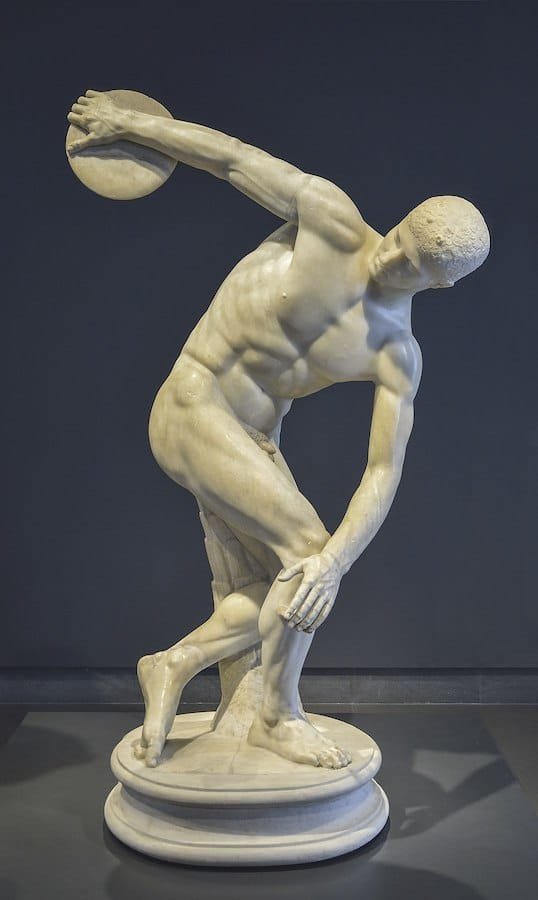
The Discobolus is a famous statue of a man throwing a discus. It was created by the Greek sculptor Myron in the 5th century BCE and is now on display at the National Roman Museum in Rome, Italy.
The statue is made of bronze and stands just over two feet tall. The Discobolus has been called one of the most iconic sculptures of antiquity. It is thought to represent the athletic ideal of the time, and its beauty has been praised for centuries. The statue is said to capture the moment just before the discus is released, and the energy and movement of the figure are conveyed with great skill.
Despite its popularity, little is known about the original context of the statue. An athlete or wealthy patron may have commissioned it or may have been part of a larger work such as a fountain or shrine. Whatever its original purpose, the Discobolus has come to be appreciated as an ancient masterpiece of Greek art.
9. The Sacred Gate Kouros – Dipylon Kouros, Archaeological Museum Athens
This ancient statue is made of Naxian marble and was created by Dipylon around 600 BC. It is 2 meters high and is a unique statue that is very well preserved. The statue was found in 2002 at the Cemetery of Kerameikos.
You can see this statue at the National Archaeological Museum in Athens.
10. Dying Warrior, Glyptothek Museum, Munich, Germany
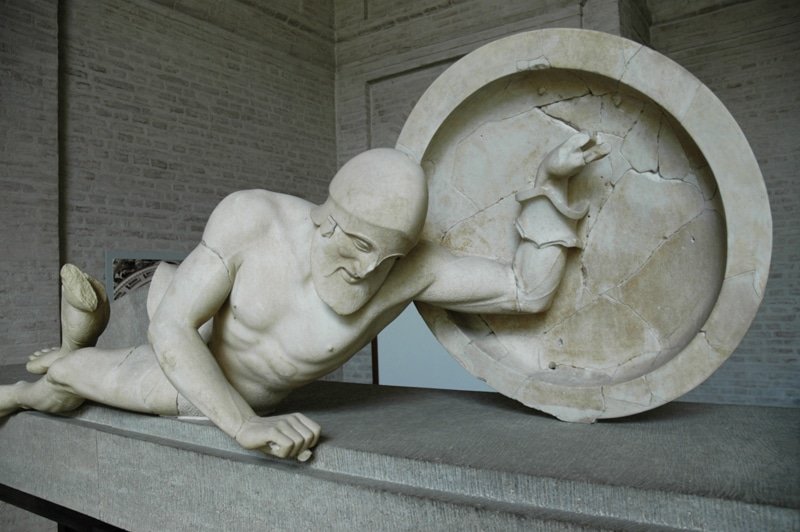
You will have to travel to Munich to see this statue, which was built around 500 BCE and dedicated to Aphaia. The statue was originally held in the Temple of Aphaia on Aegina island, and several statues were removed. The sculpture is thought to be Laomedan, a Trojan soldier and hero.
11. Moschophoros – The Calf Bearer, Acropolis Museum Athens
This particular statue dates back to around 560 BC and was found in the Acropolis in 1864. It was excavated in pieces, and it is thought that when it was initially created, it stood at 1.65 meters in height. The man in the statue is shown with a calf on his shoulders; he is a strong man with a lot of power. An inscription on the statue tells the story of the statue; from there, we can see that the creator was a wealthy person.
You can see this statue in the Acropolis Museum in Athens.
12. Heniokhos – Charioteer Of Delphi, Delphi Archaeological Museum
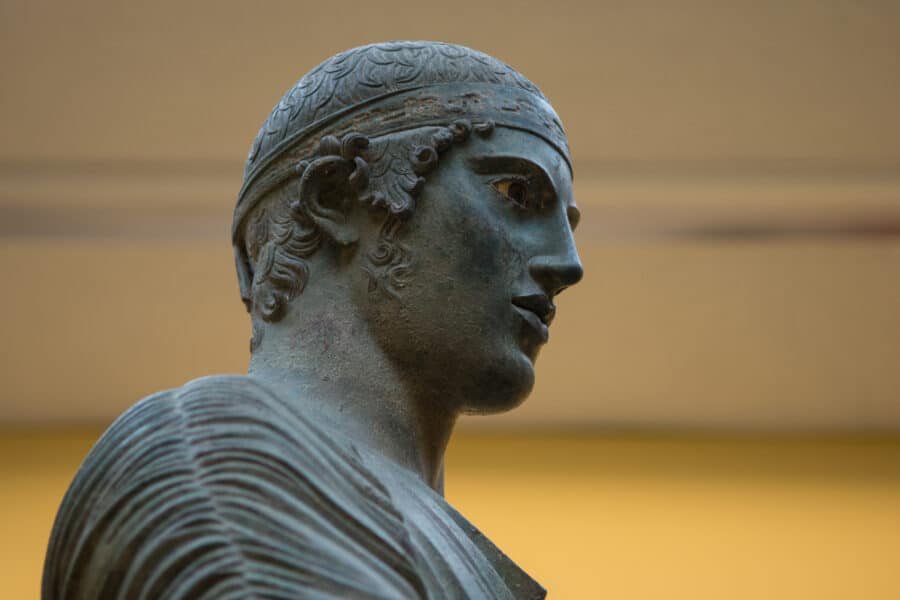
Heniokhos was found in the Sanctuary of Apollo in Delphi in 1896, and it is thought that Sotades created it in 470 BC. This is one of the oldest statues from Ancient Greece, and it depicts a chariot driver when he wins a race.
You can see this statue in the Delphi Archaeological Museum.
13. Leda and The Swan, J. Paul Getty Museum, Los Angeles
Dating back to 450 BCE, the Leda and The Swan can be found in LA. Timotheus initially created it; the famous sculpture and details are based on the story of Zeus seducing the Queen of Sparta. He did this by turning himself into a swan.
14. Kritios Boy, Acropolis Museum, Athens
Created in 480 BCE, this statue was found in 1866 during the exploration of the Acropolis site. When archaeologists found it, the head was missing, and the missing part was found 23 years later. This is a smaller sculpture and is made of marble. It is thought that the sculpture is an attempt to try and understand the human body.
15. Laocoön and His Sons, Vatican Museum
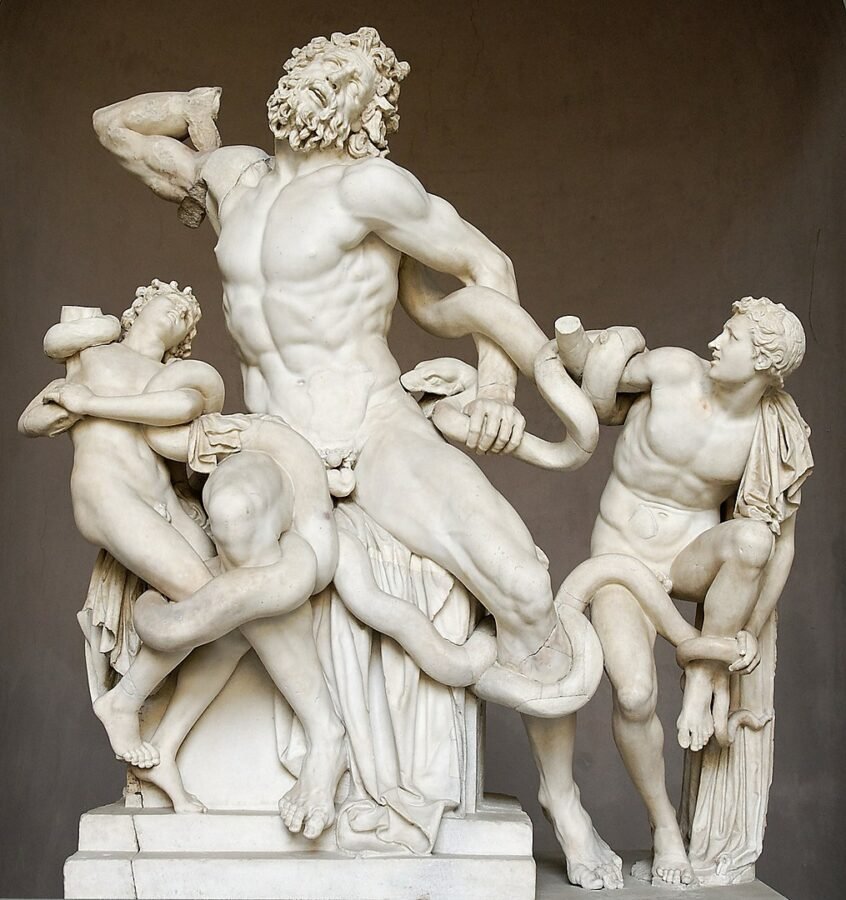
The Laocoön and His Sons sculpture is located in the Vatican Museums and is one of the most famous sculptures in the world. The sculpture depicts Laocoön, a Trojan priest, and his two sons being attacked by a giant serpent. The story behind the sculpture is that Laocoön warned the Trojans not to accept the Wooden Horse from the ancient Greeks, as it was likely a trap.
However, the Trojans did not listen to him and brought the horse into their city. As punishment for his warning, Zeus sent a giant serpent to kill Laocoön and his sons. The sculpture was created around 40 BC by an unknown Greek sculptor.
It is believed to be based on a lost painting by Polygnotus, which would have shown a similar scene. The sculpture was found in 1506 near Rome and has been on display at the Vatican Museum since 1512. The Laocoön and His Sons sculpture is one of the most famous sculptures in the world due to its detailed carving and its tragic story. If you ever have the chance to visit the Vatican Museum, be sure to see this amazing piece of art!
16. Artemision Bronze, National Archaeological Museum Athens
This particular statue was removed from Cape Artemision in 1926, and nobody knows who created it. However, it is thought to date back to around 460 BC, and it depicts Zeus or Poseidon. You can see that the man in the statue is naked and has a body that was considered ‘perfect’ for the time.
You can see this statue in the National Archaeological Museum in Athens.
The Charioteer of Delphi, Delphi Archaeology Museum, Delphi
This statue is made of bronze and was found in Delphi in 1896. You might also hear this statue named ‘The Reign Holder,’ it is thought to have been created as a nod to the Polyzalus Victoria at the Pythian Games. This sculpture was nearly destroyed in a rockfall but was fortunately recovered in time.
17. Zeus and Ganymede, Olympia Archaeological Museum
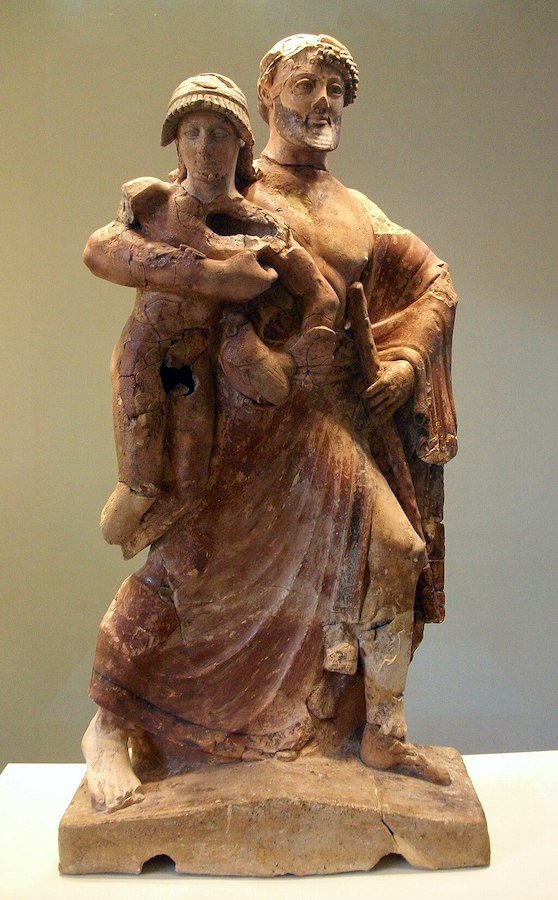
Dating back to 470 BCE, this sculpture is made of terracotta and shows Zeus carrying Ganymede on his way to Mount Olympus. It is pretty large, created to be a direct depiction, and therefore life-sized. It’s a statute of importance because it’s pretty unusual for its time, but it’s also thought to have been made between two different eras, which might explain its construction differences.
18. Statue of Zeus at Olympia, Temple of Zeus, Olympia, Greece
Visiting this statue is a must. It is huge and obviously depicts Zeus, the Greek God. The original figure was 12 meters in height and was created by Phidias, a famous sculptor of the time. It dates back to 435 BCE and is made of bronze, gold, ivory, and ebony.
19. The Riace Bronzes, Reggio Calabria, Italy
This colossal bronze statue dates back to 460 BCE and can now be found in Reggio Calabria, Italy. It was found in 1972, submerged in the seabed in Calabria, and was found by a diver on a day excursion. The diver initially worried the finding might be something sinister, as they saw an arm sticking up out of the sand, but thankfully, it turned out to be a statue and not a human!
20. The Marble Metopes of the Parthenon, The British Museum, UK
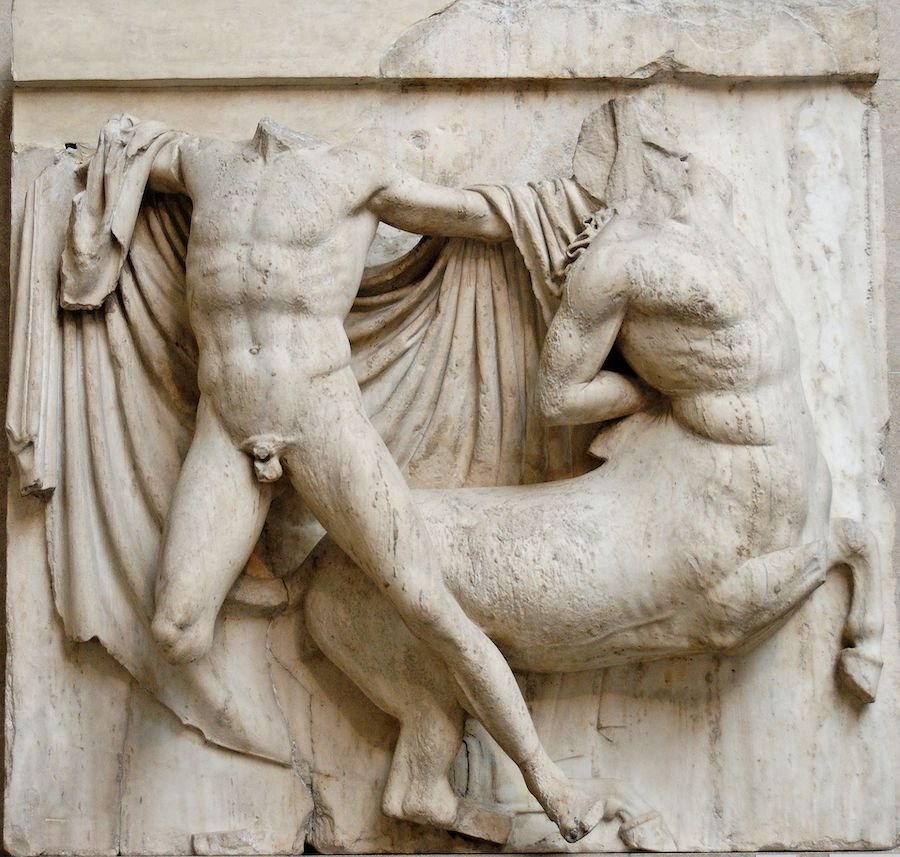
If you visit The British Museum, you will find this statue, which dates back to 438 BCE. It was initially created to make the Parthenon even more beautiful and shows different scenes from mythology.
21. Goddess Athena Parthenos, National Archaeological Museum of Athens, Athens
This is an important statue because it shows Athena, the Greek goddess of war and wisdom, and is made of gold and ivory. This is another statue belonging to Phidias, and it was originally found in the Parthenon. It was a long-admired statue and has been moved to the National Archaeological Museum of Athens to preserve its beauty.
22. The Bronzes of Siracusa, Museo Archeologico Regionale Paolo Orsi, Siracusa, Italy
Diving into the depths off the coast of Sicily led to the remarkable discovery of the Bronzes of Siracusa. These impressive bronze figures, now a highlight at the Museo Archeologico Regionale Paolo Orsi in Siracusa, Italy, are a testament to the skill of ancient metalworkers.
Pulled from their underwater resting place, these sculptures showcase the finesse of classical Greek artistry. Anyone interested in ancient artifacts or Greek mythology would be fascinated by their intricate details and the mystery of how they ended up beneath the sea.
23. The Farnese Hercules, National Archaeological Museum, Naples
If you’re into muscle and mythology, the Farnese Hercules at the National Archaeological Museum in Naples is a must-see.
This massive statue is a Roman copy of an original Greek sculpture by Glykon, capturing Hercules in a moment of tired triumph, leaning on his club after completing his famous labors.
The sheer size of this sculpture is awe-inspiring, perfectly encapsulating the strength and endurance of one of mythology’s most famous heroes.
Move This Adventure To Your Inbox & Get An Instant Freebie

No spam. Unsubscribe at any time.
24. The Diadumenos, National Archaeological Museum of Athens
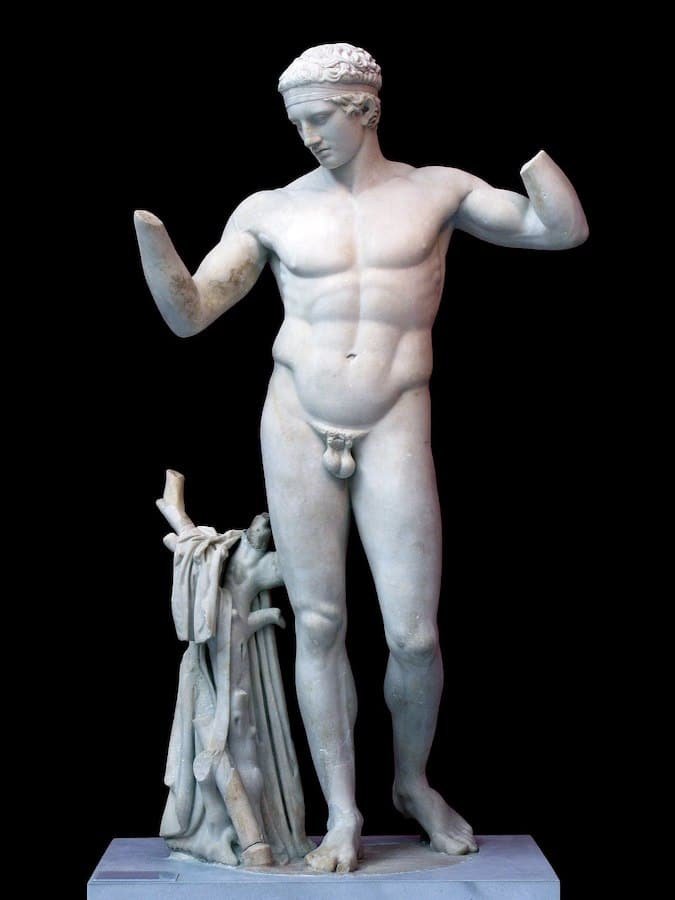
Over in the National Archaeological Museum of Athens, you’ll find the Diadumenos. This ancient Greek masterpiece, sculpted by the renowned Polykleitos, was unearthed on the island of Delos.
It portrays a young athlete tying a victory ribbon around his head, symbolizing triumph and beauty. The Diadumenos is a prime example of classical Greek sculpture, showcasing the idealized human form that has influenced artists for centuries.
25. The Barberini Faun, Glyptothek, Munich, Germany
At the Glyptothek in Munich, Germany, the Barberini Faun takes center stage. This Hellenistic sculpture of a sleeping satyr, a mythical creature known for its wild nature, is captivating in its realism and relaxed pose.
The detail in the faun’s muscular yet languid body and the peaceful expression as it sleeps is a beautiful representation of Greek art’s evolution from idealism to realism.
26. Boxer at Rest, National Roman Museum, Rome, Italy

Last but not least, the Boxer at Rest in the National Roman Museum in Rome is an absolute masterpiece of ancient bronze sculpture. Also known as the Terme Boxer, this stunning figure of a seated, resting boxer, complete with detailed features like bruises and cuts, tells a story of ancient athletic contests.
The realism and emotion captured in this sculpture make it one of the finest examples of Greek bronze work, offering a glimpse into the lives of ancient athletes.
Who were the famous Greek sculptures?
Phidias was by far the most famous of ancient Greek sculptors. Others were Praxiteles, Kritios, Lysippos, and Myron, all sculpting famous Greek God statues.
What are the most famous statues of Greek gods?
Dionysus, Zeus, Hera, Demeter, Apollo, and Artemis are the most interesting Greek statues of Gods.
We hope that this list of famous Greek statues has been interesting. Let us know in the comments below about others we should add.
- 5 Lesser-Known Greek Islands
- How To Rent A Car In Greece + Driving Tips
- How To Tip In Greece
- What To See & Do In Santorini In The Winter
- Guide To Traveling The Balkan Countries
- What To Expect & Do In September In Greece
- Unique Ideas For Kids In Greece
- Where To Stay In Mykonos
- Most Beautiful Cities In Greece
- Fascinating Facts About Greece


theys are soo cute